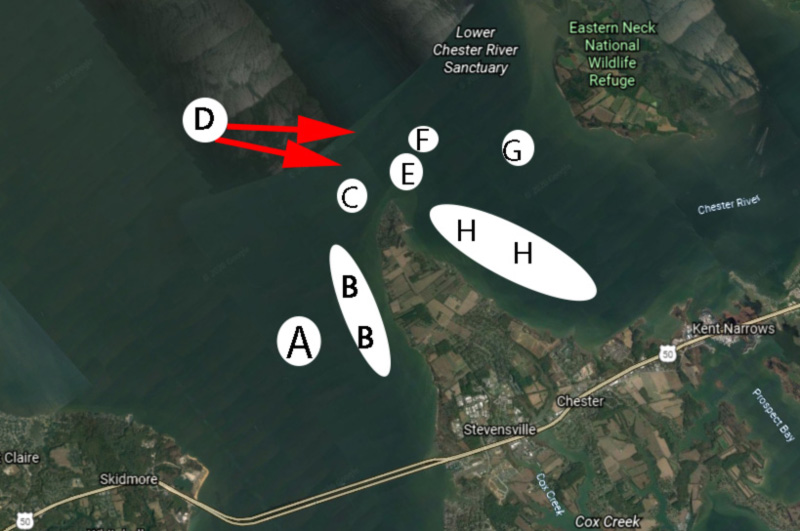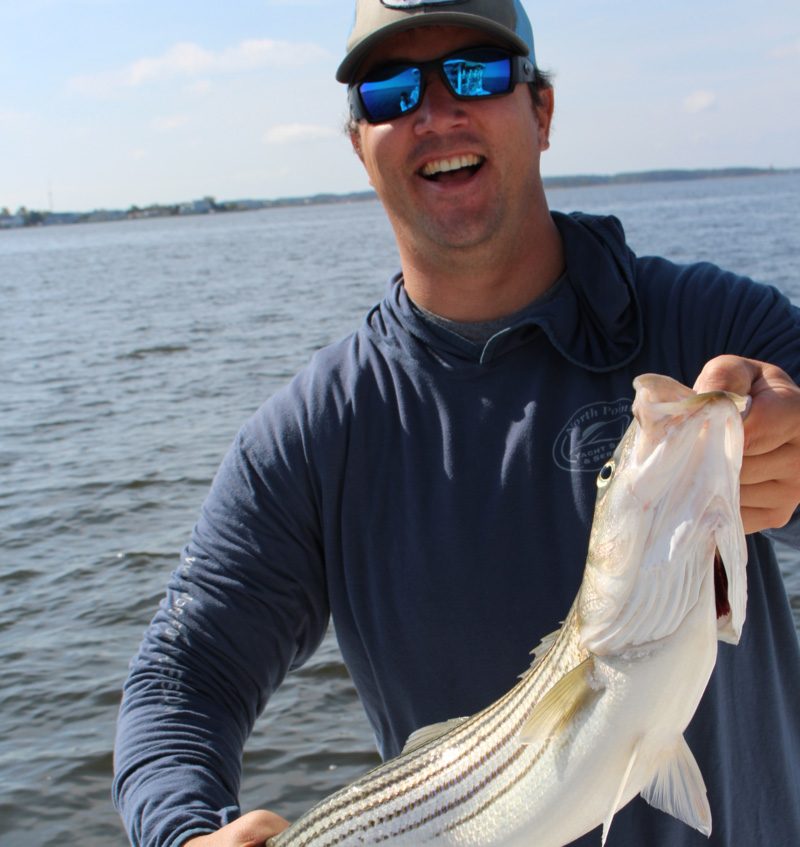Spring may be the season for amore, but if you enjoy Chesapeake Bay fishing, spring, summer and fall are all seasons for love — fishing at Love Point, that is. Take a poll of anglers who ply the Upper Bay waters and ask them about their favorite hotspots, and Love Point will come up again and again.

Why is this stretch of water so popular? First off, because there are lots of fish in this zone. Clearer water with higher salinity than the western shore enjoys works its way up along Kent Island, and from the tip of land called Love to the old Susquehanna riverbed there’s a tremendous depth range, so this area has something to offer both shallow water light-tackle angers and deep-water trollers. Chumming, trolling, working birds — you name it, and it can happen for you here. Yet when one refers to Love Point without a more specific description, there are many square miles of territory that could be interpreted as the area. To one angler fishing “at Love Point” may mean trolling un and down along the drop-off in 40 feet of water west of the northernmost part of Kent Island. But to another, it could mean chasing schools of striped bass within the southern section of the mouth of the Chester River. So when you hear Love calling, how will you know where to go? Figuring it out requires an in-depth look.
Bottom of Your Heart
The bottom along the deep Love Point mud flats (A) is the first area to note; it runs parallel along Love Point about a mile and a half from land, and continues up along the mouth of the Chester and down towards the bridge. Depths range from the mid-30s on the western slope to 45’ on the eastern side, before the flats slide down into the depths of the deepwater channel. These flats are used by some bait anglers as spring trophy striper chumming grounds, and at times trollers will zigzag across the mud flats to locate either spring trophies or fall schools of schoolies chasing bunker. Jigging or live baiting usually won’t be as effective in this zone, because the fish aren’t commonly schooled tightly or focused on a specific item of structure; you’ll need to either draw them in or stay on the move.
Edge of Love
The next area anglers need to know about is the edge of the drop-off from the shallow water extending off Kent island, down into the depths of the old Susquehanna riverbed (B). This edge is a major-league feature, and may be holding fish through any portion of the spring, summer, or fall. Anchoring along the edge and live-lining or chumming is effective here in the summer and fall, but trollers working back and forth along the drop will take their share of fish at all times of the year.
When it comes to scoring big here, however, savvy anglers will look for the “Love Handles,” a pair of outcroppings in the 20- to 30-foot section of the drop (C), which come up to 15’, to the northwest of the point. You’ll be right in the middle of the outcropping at 39’03.00 x 76’19.25. The hard-shell bottom here is erratic and changes abruptly, and often, fish will hang close to this structure. Any method can work here, but thanks to the significant structure this is a favored spot of jiggers and light tackle anglers. Trollers will also find that during the fall season this can be a killer spot to try traditional bottom-bouncing tactics with three- or four-inch bucktails trimmed with a twister tail or a large bull minnow. Keep the rod working with long sweeps towards the bow followed by drop-backs and letting out or retrieving line, as necessary, to keep that bucktail right on bottom as you go over the edges. Anglers should also file away this spot as somewhere to check when bottom fishing, because spot, croaker, and perch are all possibilities here.
Your Shoal Desire
Up closer to the land that we call Love, there’s an excellent chance of finding breaking stripers during the fall. The relatively shallow, 12- to 15-foot flat running between the Love Handles and land, up to the red #2 marker to the north (D), is for some reason a favorite spot for surface-feeding fish. You’ll catch them with any of the usual methods used when fishing under birds, but beware: some seasons, 99 out of 100 of these fish will be throwbacks. There does seem to be a direct correlation between water depth and fish size when catching them on the surface here, and if the fish are out a bit deeper in 18 or 20 feet of water there is a much greater chance of putting a striper or two in the box. Generally speaking, if you hit a school of birds working in this zone and catch a handful of 12-inch fish, it’s wise to move on and look for bigger, better quarry instead of hoping to eventually weed out a fish for the cooler.
There’s also good visible structure here, at the light pole rocks and riprap (E). Tossing jigs is usually the best bet for stripers here, though in the mid-summer months anglers will send live spot flying through the air and into the target zone. Often overlooked, however, is the excellent perch fishing potential. Bottom rigs baited with bloodworm or grass shrimp will certainly take plenty of fish but get too close to the rocks and you risk snagging, so flinging small Perch Pounders, Beetle Spins, and Mepps can be a better option.
The northern edge of this shoal, about two and a half miles up from Love Point where the water drops from 15 to 35 feet, is another good spot to keep in mind for live baiting, chumming, and trolling. Breaking fish will appear here from time to time as well. It’s clearly marked by the #2 nun buoy, so this spot (F) is a piece of cake to find. It’s particularly good on an outgoing tide, when the moving water smacks into the edge and curls it around to exit the Chester. When that water’s rushing out make sure you set up on the eastern side of the edge, to take full advantage of the conditions.
Love the River

Although it would more accurately be described as in the Chester river than as off Love Point, the hump sticking out at the green #3 can, east of the point, is another excellent feature (G) that Love-lovers should check out. This hump comes up to 15 feet and is bordered by drops to 20 feet to 30’ on three sides, and is an excellent spot to drop the hook and chum or liveline for stripers on days when a strong south wind prevents you from running out into the main-stem Bay. Again, you’re going to locate the bulk of the active fish here on the up-current side of the structure. If it’s an outgoing fish on the southern side of the hump, and on an incoming, try the northern side.
Running west from here, the entire 18- to 25-foot zone from the north-side light tower clear down to Castle Haven is an annual producer for fall jigging and fall trolling (H). Pods of fish will link up and form schools starting in September or October and chase bait throughout the area, often under patches of fast-moving birds that constantly group up, break apart, and reform. Bouncing a four- to six-inch soft plastic along bottom when you see fish on the meter within a few hundred feet of birds is often a solid bet for fish that many seasons will get up into the 30-plus-inch range.
Check out these waters and there’s a good chance that before you know it, you’ll fall head over heels. Just remember to grab a bouquet of flowers on the way home, so your spouse doesn’t get jealous every time you head for Love Point.
Sign up here to get the weekly FishTalk Chesapeake Bay and Mid-Atlantic fishing reports in your email inbox, every Friday by noon.